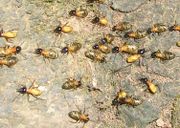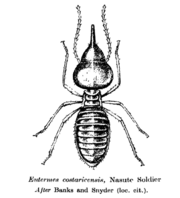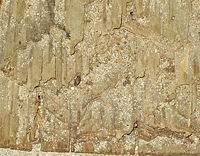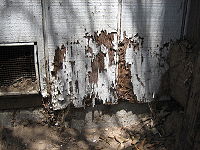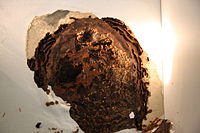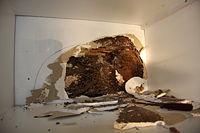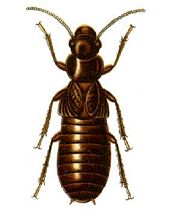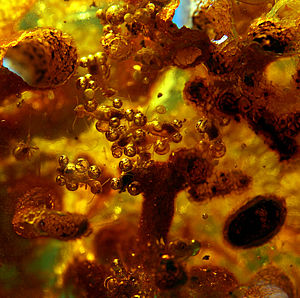Termite
2008/9 Schools Wikipedia Selection. Related subjects: Insects, Reptiles and Fish
| Termites Fossil range: Late Triassic - Recent |
||||||||||||||
|---|---|---|---|---|---|---|---|---|---|---|---|---|---|---|
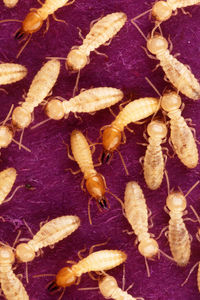 Formosan subterranean termite soldiers (red colored heads) and workers (pale colored heads).
|
||||||||||||||
| Scientific classification | ||||||||||||||
|
||||||||||||||
| Families | ||||||||||||||
|
Hodotermitidae |
Termites, sometimes incorrectly called "white ants", are a group of social insects usually classified at the taxonomic rank of order Isoptera. (This has been challenged by recent research, see taxonomy below.) Termites mostly feed on dead plant material, generally in the form of wood, leaf litter, soil, or animal dung, and about 10% of the estimated 4,000 species (about 2,600 taxonomically known) are economically significant as pests that can cause serious structural damage to buildings, crops or plantation forests. Termites are major detrivores, particularly in the subtropical and tropical regions, and their recycling of wood and other plant matter is of considerable ecological importance.
As social insects, termites live in colonies that, at maturity, number from several hundred to several million individuals. They are a prime example of decentralised, self-organised systems using swarm intelligence and use this cooperation to exploit food sources and environments that could not be available to any single insect acting alone. A typical colony contains nymphs (semi-mature young), workers, soldiers, and reproductive individuals of both genders, sometimes containing several egg-laying queens.
Social organization
Reproductives
A female that has flown, mated and is producing eggs, is called a "Queen". Similarly, a male that has flown, mated and remains in proximity to a queen, is termed a "King". These anthropocentric terms have caused great misunderstanding of colony dynamics. Research using genetic techniques to determine relatedness of colony members is showing that the idea that colonies are only ever headed by a monogamous royal pair is wrong. Multiple pairs of reproductives within a colony are not uncommon. In the families Rhinotermitidae and Termitidae, and possibly others, sperm competition does not seem to occur (male genitalia are very simple and the sperm are anucleate), suggesting that only one male (king) generally mates within the colony.
At maturity, a primary queen has a great capacity to lay eggs. In physogastric species, the queen adds an extra set of ovaries with each moult, resulting in a greatly distended abdomen and increased fecundity, often reported to reach a production of more than two thousand eggs a day. The distended abdomen increases the queen's body length to several times more than before mating and reduces her ability to move freely, however attendant workers provide assistance. The queen is widely believed to be a primary source of pheromones useful in colony integration and these are thought to be spread through shared feeding ( trophallaxis).
The king grows only slightly larger after initial mating and continues to mate with the queen for life. This is very different from ant colonies, in which a queen mates once with the male(s) and stores the gametes for life, and the male ants die shortly after mating.
The winged (or 'alate') caste, also referred to as the reproductive caste, are generally the only termites with well-developed eyes (although workers of some harvesting species do have well-developed compound eyes and in other species soldiers with eyes occasionally appear). Termites on the path to becoming alates (going through incomplete metamorphosis) form a sub-caste in certain species of termites, functioning as functional workers ('pseudergates') and also as potential supplementary reproductives. Supplementaries have the ability to replace a dead primary reproductive and in at least some species several are recruited once a primary queen is lost.
In areas with a distinct dry season, the alates leave the nest in large swarms after the first good soaking rain of the rainy season. In other regions, flights may occur throughout the year or more commonly in the Spring and Autumn ('Fall'). Termites are relatively poor flyers and are readily blown downwind in windspeeds of less than 2 kph, shedding their wings soon after landing at an acceptable site, where they mate and attempt to form a nest in damp timber or earth.
Workers
Worker termites undertake the labours of foraging, food storage, brood, nest maintenance and some of the defence effort in certain species. Workers are the main caste in the colony for the digestion of cellulose in food and are the most likely to be found in infested wood. This is achieved in one of two ways. In all termite families except the Termitidae, there are flagellates ( Protista) in the gut that assist in cellulose digestion. However, in the Termitidae, which account for approximately 60% of all termite species, the flagellates have been lost and this digestive role is taken up, in part, by a consortium of prokaryotic organisms. This simple story, which has been in Entomology textbooks for decades, is complicated by the finding that all studied termites can produce their own cellulase enzymes, and therefore can digest wood in the absence of their symbiotic microbes. Our knowledge of the relationships between the microbial and termite parts of their digestion is still rudimentary. What is true in all termite species, however, is that the workers feed the other members of the colony with substances derived from the digestion of plant material, either from the mouth or anus. This process of feeding of one colony member by another is known as trophallaxis, and is one of the keys to the success of the group as it frees the parents from feeding all but the first generation of offspring, allowing for the group to grow much larger and ensuring that the necessary gut symbionts are transferred from one generation to another.
Termite workers are generally blind due to undeveloped eyes. Despite this limitation they are able to create elaborate nests and tunnel systems using a combination of soil, chewed wood /cellulose, saliva and faeces. Some species have been known to create such durable walls that industrial machinery has been damaged in an attempt to break their tall mounds. Some African and Australian species have mounds more than 4 metres high. The nest is created and maintained by workers with many distinct features such as housing the brood, water collection through condensation, reproductive chambers, and tunnel networks that effectively provide air conditioning and control the CO2/O2 balance. A few species even practice agriculture, with elaborate fungal gardens which are fed on collected plant matter, providing a nutritious mycelium on which the colony then feeds (see Diet, below).
Soldiers
The soldier caste has anatomical and behavioural specializations, providing strength and armour which are primarily useful against ant attack. The proportion of soldiers within a colony varies both within and among species. Many soldiers have jaws so enlarged that they cannot feed themselves, but instead, like juveniles, are fed by workers. The pan-tropical sub family Nasutitermitinae (which should probably have the South American species separated) have soldiers with the ability to exude noxious liquids through either a horn-like nozzle (nasus) or simple hole in the head ( fontanelle). Fontanelles which exude defensive secretions are also a feature of the family Rhinotermitidae. Many species are readily identified using the characteristics of the soldiers' heads, mandibles, or nasus. Among the drywood termites, a soldier's globular ("phragmotic") head can be used to block their narrow tunnels. Termite soldiers are usually blind, but in some families, soldiers developing from the reproductive line may have at least partly functional eyes.
It's generally accepted that the specialization of the soldier caste is principally a defence against predation by ants. The wide range of jaw types and phragmotic heads provides methods which effectively block narrow termite tunnels against ant entry. A tunnel-blocking soldier can rebuff attacks from many ants. Usually more soldiers stand by behind the initial soldier so once the first one falls another soldier will take the place. In cases where the intrusion is coming from a breach that is larger than the soldier's head, defence requires special formations where soldiers form a phalanx-like formation around the breach blindly biting at intruders or shooting toxic glue from the nasus. This formation involves self-sacrifice because once the workers have repaired the breach during fighting no return is provided, causing the death of all the defenders.
Termites undergo incomplete metamorphosis, with their freshly hatched young taking the form of tiny termites that grow without significant morphological changes (other than wings and soldier specializations). Some species of termite have dimorphic soldiers (up to 3 times the size of smaller soldiers). Though their value is unknown, speculation is that they may function as an elite class that defends only the inner tunnels of the mound. Evidence for this is that, even when provoked, these large soldiers do not defend themselves but retreat deeper into the mound. On the other hand, dimorphic soldiers are common in some Australian species of Schedorhinotermes that neither build mounds nor appear to maintain complex nest structures. Some termite taxa are without soldiers; perhaps the best known of these are the Apicotermitinae.
Diet
Termites are generally grouped according to their feeding behaviour. Thus the commonly used general groupings are: Subterranean, Soil-feeding, Drywood, Dampwood, and Grass-eating. Of these, subterraneans and drywoods are primarily responsible for damage to human-made structures.
All termites eat cellulose in its various forms as plant fibre. Cellulose is a rich energy source (think of the amount of energy released when wood is burned), but remains difficult to digest. Termites rely primarily upon symbiotic protozoa ( metamonads) such as Trichonympha, and other microbes in their gut to digest the cellulose for them, absorbing the end products for their own use. Gut protozoa such as Trichonympha, in turn rely on symbiotic bacteria embedded on their surfaces to produce some of the necessary digestive enzymes. This relationship is one of the finest examples of mutualism among animals. Most so called "higher termites", especially in the Family Termitidae can produce their own cellulase enzymes. However, they still retain a rich gut fauna with bacteria dominant. Due to closely related bacterial species, it is strongly presumed that the termites' gut flora are descended from the gut flora of the ancestral wood-eating cockroaches, like those of the genus Cryptocercus.
Some species of termite practice fungiculture - they maintain a 'garden' of specialized fungi of genus Termitomyces, which are nourished by the excrement of the insects. When the fungi in turn are eaten, their spores pass undamaged through the intestines of the termites, to complete the cycle by germinating in the fresh faecal pellets. They are also well known for eating smaller insects in a last resort environment.
Mounds
Termites build nests to house their colonies. Nests are commonly located in larger timber or in the soil in locations such as growing trees, inside fallen trees, underground, and in above-ground mounds which they construct, commonly called "anthills" in Africa and Australia, despite the technical incorrectness of that name. Mounds occur when the nest grows beyond its initially concealing surface. In tropical savannas the mounds may be very large, with an extreme of 9 metres (30 ft) high in the case of large conical mounds constructed by some Macrotermes species in well-wooded areas in Africa, though 2–3 m would be typical for the largest mounds in most savannas. The shape ranges from somewhat amorphous domes or cones usually covered in grass and/or woody shrubs, to sculptured hard earth mounds, or a mixture of the two. Despite the irregular mound shapes, the different species in an area can usually be identified by simply looking at the mounds.
The sculptured mounds sometimes have elaborate and distinctive forms, such as those of the compass termite (Amitermes meridionalis & A. laurensis) which build tall wedge-shaped mounds with the long axis oriented approximately north-south. This orientation has been experimentally shown to help in thermoregulation.
The column of hot air rising in the above ground mounds helps drive air circulation currents inside the subterranean network. The structure of these mounds can be quite complex. The temperature control is essential for those species that cultivate fungal gardens and even for those that don't, much effort and energy is spent maintaining the brood within a narrow temperature range, often only plus or minus one degree C over a day.
In some parts of the African savanna a high density of above-ground mounds dominates the landscape. For instance in some parts of the Busanga Plain area of Zambia, small mounds of about 1 m diameter with a density of about 100 per hectare can be seen on grassland between larger tree- and bush-covered mounds about 25 m in diameter with a density around 1 per hectare, and both show up well on high-resolution satellite images taken in the wet season..
Human interaction
Because of their wood-eating habits, termites sometimes do great damage to buildings and other wooden structures. Their habit of remaining concealed often results in their presence being undetected until the timbers are severely damaged and exhibit surface changes. Once termites have entered a building they do not limit themselves just to wood, also damaging paper, cloth, carpets, and other cellulosic materials. Often, other soft materials are damaged and may be used for construction. Particles taken from soft plastics, plaster, rubber and sealants such as silicon rubber and acrylics are often employed in construction.
Termites usually avoid exposure to unfavourable environmental conditions. They tend to remain hidden in tunnels in earth and wood. Where they need to cross an impervious or unfavourable substrate, they cover their tracks with tubing made of faeces, plant matter, and soil. Sometimes these shelter tubes will extend for many metres, such as up the outside of a tree reaching from the soil to dead branches. Termite barrier systems used for protecting buildings aim to prevent concealed termite access, thus forcing the termites out into the open where they must form clearly visible shelter tubes to gain entry.
Termites can be major agricultural pests, particularly in Africa and Asia where crop losses can be severe but counterbalancing this is the greatly improved water infiltration where termite tunnels in the soil allow rainwater to soak in deeply and help reduce runoff and consequent soil erosion.
In many cultures, termites are used for food (particularly the alates) and termite nests are used widely in construction (the dirt is often dust-free) and as a soil amendment.
Humans have moved many wood-eating species between continents, but have also caused drastic population decline in others through habitat loss and pesticide application.
Avoiding termite troubles
Precautions:
- Avoiding contact of susceptible timber with ground by using termite-resistant concrete, steel or masonry foundation with appropriate barriers. Even so, termites are able to bridge these with shelter tubes, and it has been known for termites to chew through piping made of soft plastics and even lead to exploit moisture. In general, new buildings should be constructed with embedded physical termite barriers so that there are no easy means for termites to gain concealed entry. While barriers of poisoned soil have been in general use since the 1970s, it is preferable that these be used only for existing buildings without effective physical barriers.
- The intent of termite barriers (whether physical, poisoned soil, or some of the new poisoned plastics) is to prevent the termites from gaining unseen access to structures. In most instances, termites attempting to enter a barriered building will be forced into the less favourable approach of building shelter tubes up the outside walls and thus they be clearly visible both to the building occupants and a range of predators. Regular inspection by a competent (trained and experienced) inspector is the best defence.
- Timber treatment.
- Use of timber that is naturally resistant to termites such as Canarium australianum (Turpentine Tree), Callitris glaucophylla (White Cypress), or one of the Sequoias. Note that there is no tree species whose every individual tree yields only timbers that are immune to termite damage, so that even with well known termite-resistant timber types, there will occasionally be pieces that are attacked.
When termites have already penetrated a building, the first action is usually to destroy the colony with insecticides before removing the termites' means of access and fixing the problems that encouraged them in the first place. Baits (feeder stations) with small quantities of disruptive insect hormones or other very slow acting toxins have become the preferred least-toxic management tool in most western countries. This has replaced the dusting of toxins direct into termite tunnels which had been widely done since the early 1930s (originating in Australia). The main dust toxicants have been the inorganic metallic poison arsenic trioxide, insect growth regulators (hormones) such as Triflumuron and, more recently, fipronil. Blowing dusts into termite workings is a highly skilled process. All these slow-acting poisons can be distributed by the workers for considerable periods (hours to weeks) before any symptoms occur and are capable of destroying the entire colony. More modern variations include chlorfluazuron, Diflubenzuron, hexaflumuron, and Novaflumuron as bait toxicants and fipronil and imidacloprid as soil poisons. Soil poisons are the least-preferred method of control as this requires much larger doses of toxin and results in uncontrollable release to the environment.
Termites in the human diet
The alates are nutritious, having a good store of fat and protein, and are palatable in most species with a nutty flavour when cooked. They are easily gathered at the beginning of the rainy season in Central and Southern Africa when they swarm, as they are attracted to lights and can be gathered up when they land on nets put up around a lamp. The wings are shed and can be removed by a technique similar to winnowing. They are best gently roasted on a hot plate or lightly fried until slightly crisp, oil is not usually needed since their bodies are naturally high in oil. Traditionally they make a welcome treat at the beginning of the rainy season when livestock is lean, new crops have not yet produced food and stored produce from the previous growing season is running low.
Ecology
Ecologically, termites are important in nutrient recycling, habitat creation, soil formation and quality and, particularly the winged reproductives, as food for countless predators. The role of termites in hollowing timbers and thus providing shelter and increased wood surface areas for other creatures is critical for the survival of a large number of timber-inhabiting species. Larger termite mounds play a role in providing a habitat for plants and animals, especially on plains in Africa which are seasonally inundated by a rainy season, providing a retreat above the water for smaller animals and birds, and a growing medium for woody shrubs with root systems that cannot withstand inundation for several weeks. In addition, scorpions, lizards, snakes, small mammals and birds live in abandoned or weathered mounds, and aardvarks dig substantial caves and burrows in them, which then become homes for larger animals such as hyenas and mongooses.
As detrivores, termites clear away leaf and woody litter and so reduce the severity of the annual bushfires in African savannas, which are not as destructive as those in Australia and the USA.
Globally termites are found roughly between 50 degrees North & South, with the greatest biomass in the tropics and the greatest diversity in tropical forests and Mediterranean shrublands. Termites are also considered to be a major source of atmospheric methane, one of the prime greenhouse gases. Termites have been common since at least the Cretaceous period. Termites also eat bone and other parts of carcasses, and their traces have been found on dinosaur bones from the middle Jurassic in China.
Plant defences against termites
Many plants have developed effective defences against termites and in most ecosystems there is an observable balance between the growth of plants and the feeding of termites. Typically defence is achieved by secreting into the woody cell walls, anti-feedant chemicals (such as oils, resins, and lignins) which reduce the ability of termites to efficiently digest the cellulose. Many of the strongly termite-resistant tree species have heartwood timber that is extremely dense (such as Eucalyptus camaldulensis) due to accretion of these resins. Over the years there has been considerable research into these natural defensive chemicals with scientists seeking to add them to timbers from susceptible trees. A commercial product, "Blockaid", has been developed in Australia which uses a range of plant extracts to create a paint-on non-toxic termite barrier for buildings. In 2005, a group of Australian scientists "discovered" (announced) a treatment based on an extract of a species of Eremophila that repels termites. Tests have shown that termites are strongly repelled by the toxic material to the extent that they will starve rather than cross treated samples and when kept in close proximity to the extract become disoriented and eventually die. These scientists hope to use this toxic compound commercially to prevent termite feeding.
Taxonomy, evolution and systematics
Recent DNA evidence has supported the nearly 120 year-old hypothesis, originally based on morphology, that termites are most closely related to the wood-eating cockroaches (genus Cryptocercus), to which the singular and very primitive Mastotermes darwiniensis shows some tell-tale similarities. Most recently this has led some authors to propose that termites be reclassified as a single family, Termitidae, within the order Blattodea, which contains cockroaches . However, most researchers advocate the less drastic measure of retaining the termites as Isoptera but as a group subordinate to true roaches, preserving the internal classification of termites .
Evolutionary history
The oldest unambiguous termite fossils date to the early Cretaceous although structures from the late Triassic have been interpreted as fossilized termite nests. Given the diversity of Cretaceous termites, it is likely that they had their origin at least sometime in the Jurassic.
It has long been accepted that termites are closely related to cockroaches and mantids, and they are classified in the same superorder ( Dictyoptera), but new research has shed light on the details of termite evolution. There is now strong evidence suggesting that termites are really highly modified, social, wood-eating cockroaches. A study conducted by scientists has found that endosymbiotic bacteria from termites and a genus of cockroaches, Cryptocercus, share the strongest phylogenetical similarities out of all other cockroaches. Both termites and Cryptocercus also share similar morphological and social features -- most cockroaches do not show social characteristics, but Cryptocercus takes care of its young and exhibits other social behaviour. As mentioned above, the primitive Giant Northern Termite (Mastotermes darwiniensis) exhibits numerous cockroach-like characteristics that are not shared with other termites.
Systematics
As of 1996, about 2,800 termite species are recognized, classified in seven families . These are arranged here in a phylogenetic sequence, from the most basal to the most advanced:
- Mastotermitidae (1 species, Mastotermes darwiniensis)
- Hodotermitidae (3 genera, 19 species)
- Hodotermitinae
- Kalotermitidae (22 genera, 419 species)
- Termopsidae (5 genera, 20 species)
- Termopsinae
- Porotermitinae
- Stolotermitinae
- Rhinotermitidae (14 genera, 343 species)
- Coptotermitinae Holmgren
- Heterotermitinae Froggatt
- Prorhinoterminae Quennedey & Deligne, 1975
- Psammotermitinae Holmgren
- Rhinotermitinae Froggatt
- Stylotermitinae Holmgren, K & N, 1917
- Termitogetoninae Holmgren
- Serritermitidae (1 species, Serritermes serrifer)
- Termitidae (236 genera, 1958 species)
- Macrotermitinae (14 genera, 349 species)
- Nasutitermitinae (91 genera, 663 species)
- Amitermitinae (17 genera, 295 species)
- Apicotermitinae (43 genera, 202 species)
- Cubitermitinae (28 genera, 161 species)
- Termitinae (43 genera, 288 species)
The most current classification of termites is summarized by Engel & Krishna (2004).

